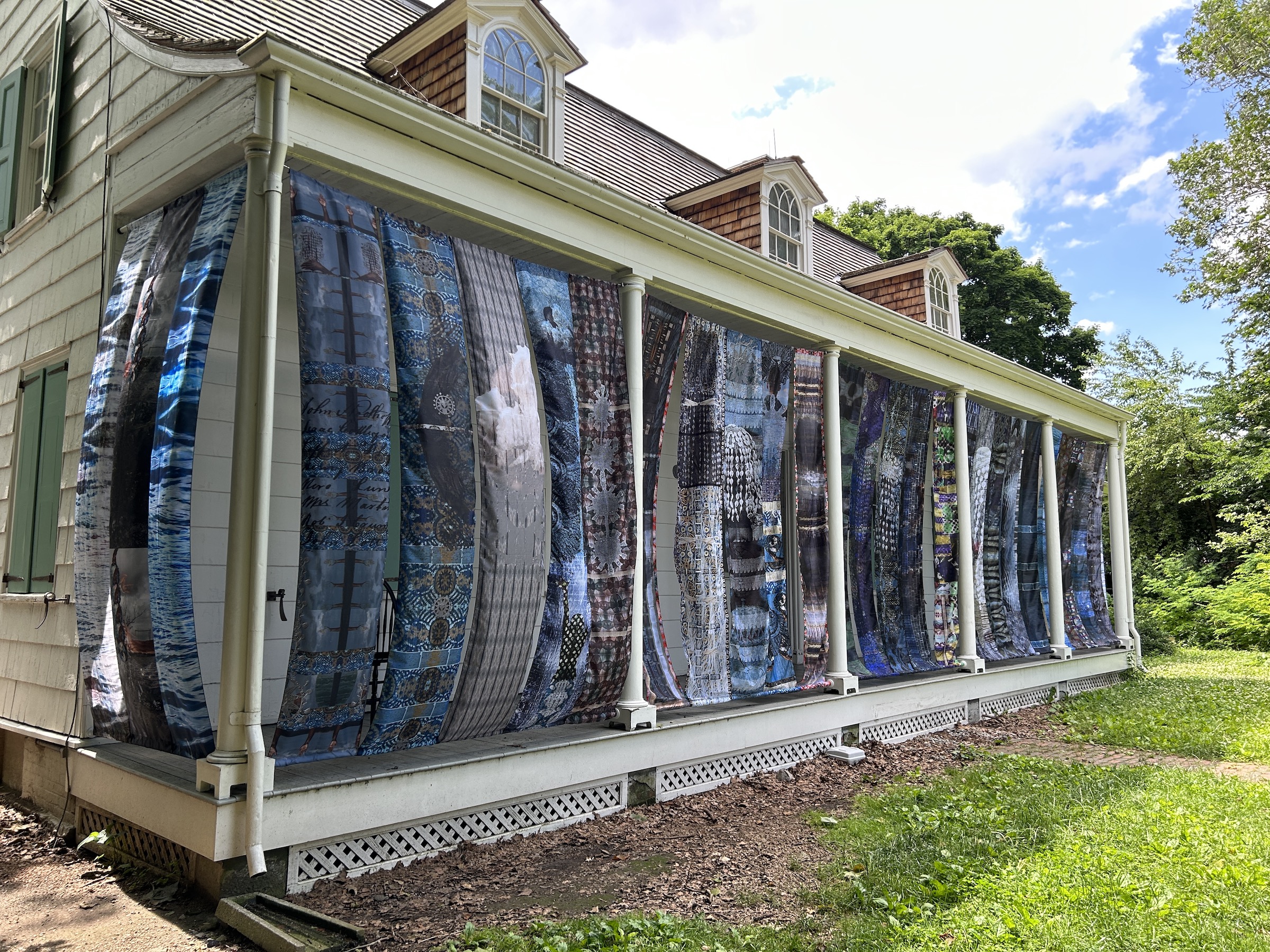
[ad_1]
Like many people who grow up in Brooklyn, Adama Delphine Fawundu remembers spending much of her childhood and adolescence in Prospect Park. Yet she never recalled learning about the stories behind the 526-acre green space’s structures and sites, such as the 18th-century farmhouse that once belonged to the family of Continental Army Lieutenant Pieter Lefferts, situated near the park’s eastern entrance at the corner of Flatbush and Ocean Avenues. As with many of the historical structures scattered across her neighborhood, Fawundu never really thought much about the Lefferts Historic House and its past until she grew older and gained a greater understanding of New York’s legacy of slavery.
“I kind of thought, ‘Okay, this is it,’” Fawundu told Hyperallergic. “‘Something had to happen in this house, right?’”
Now, over 150 years since the end of slavery in the United States, this history is front and center in Fawundu’s new site-specific installation “Ancestral Whispers,” which she created as the Prospect Park Alliance’s inaugural ReImagine Lefferts artist-in-residence.

In 2020, the artist realized her instincts about the Lefferts Historic House were correct while combing through records kept by the Brooklyn Historical Society for a research project. That’s where she came across Anna and Isaac — two people who were once enslaved by the Lefferts family. In the years since this discovery, the ReImagine Lefferts initiative, which aims to contextualize the house with regard to its role in enslavement and Indigenous land dispossession, has identified the names of at least 25 people who were enslaved at the house between its construction in 1783 and the abolition of slavery in New York in 1827.
On view until December 1, “Ancestral Whispers” features 31 kaleidoscopic banners inspired by and named after these 25 individuals. Hanging from the house’s porch facing Flatbush Avenue, the translucent banners layer diverse elements including West African cultural symbols, scans of birth records and sales receipts, and bodily forms created from photographs of Fawundu, her son, and her grandmother.


Coinciding with the outdoor banner installation, Fawundu’s video performance work “In the Face of History Freedom Cape” (2020) is on view inside the house. The work centers the voices of Black women and nonbinary individuals reflecting on the issue of voting in the wake of the 2020 Black Lives Matter protests. Filmed in Prospect Park and around the Lefferts House, the piece involved Fawundu’s “Freedom Cape” (2020), also on display, featuring the silhouettes of Black women transposed onto historical documents such as newspapers and voting flyers.
In another room, a meditative, shrine-like installation titled “Ancestral Hymns…an Ensemble #1 – 12” (2024) presents 12 smaller collage banners featuring elements like hair and flax arranged around a circle of candles.


ReImagine Lefferts Public Programs Manager Riah Kinsey, who grew up in Queens and now works full-time at the house alongside Project Manager Dylan Yeats, explained that one of the first things he wanted to do when he visited the house was install altars — much like Fawundu’s instincts when she later came to visit the space. Now, the rooms in the Lefferts House are adorned with clusters of candles and bits of dried grass and flowers. “That’s something that she wasn’t planning,” Kinsey explained. “She said that when she just started setting up in the space, it was just what she felt called to do.”

In addition to contending with ReImagine Lefferts’s history of enslavement, the initiative is reckoning with the site’s land dispossession during the Dutch colonization of Manhattan and the Hudson region. Project coordinators are currently working with the Eenda-Lunaapeewahkiing Collective, a group of four Lenape tribal governments, to incorporate different installations and programming focusing on Lenape cultural heritage. They hope to eventually have more communities join the project to share their voices and histories through a panel installation in front of the house, as well as another work honoring the Lenape creation story.
“Our vision is to unite and hear the voices of Lenape across Turtle Island,” Brent Stonefish, an educator and culture-bearer from Eelūnaapèewi Lahkèewiit, told Hyperallergic, adding that while the Lenape may no longer be in Brooklyn due to forced removal and land dispossession, they are still here, scattered across Turtle Island in places like Oklahoma, Kansas, Missouri, Wisconsin, Ontario, and New Jersey.

Local organizations, such as the Weeksville Heritage Center and the Flatbush African Burial Ground Coalition, are also helping to transform the space into one that can be utilized by local community groups.
“The building always looked spooky and haunted to me and it wasn’t inviting,” Shanna Sabio, a co-trustee of the Flatbush African Burial Ground Coalition and founder of the local organization GrowHouse, told Hyperallergic. Growing up in Brooklyn, Sabio remembered taking a school trip to the house and feeling very disconnected from its history. But she said that the new effort to “reimagine” the site has shone a light on historical issues that are still relevant today.
“Today’s gentrification and displacement are built on the blueprint of the original displacement of Lenape people from their homeland,” Sabio said. “Art and narrative storytelling make these truths easier to consume, allowing beauty to soften the landing of these truths and inspire change.”
[ad_2]